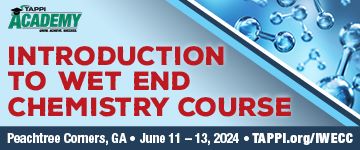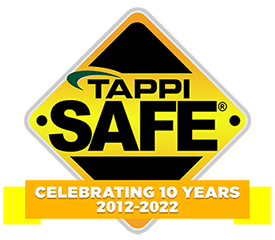 Search
Search
Use the search bar or filters below to find any TAPPI product or publication.
Filters
Content Type
Publications
Level of Knowledge
Collections
Journal articles

Magazine articles

Furnishing autohydrolyzed poplar weakly alkaline P-RC APMP to make lightweight coated base paper, TAPPI Journal February 2022
ABSTRACT: This work investigated the effects of autohydrolysis pretreatment severity on poplar (Populus tomentosa Carr.) woodchips used to make a type of high-yield pulp (HYP) known as preconditioning followed by refiner chemical treatment, alkaline peroxide mechanical pulp (P-RC APMP). It also investigated the ratios for partially replacing sodium hydroxide (NaOH) with magnesium oxide (MgO) in the high-consistency (HC) retention stage of the P-RC APMP process on the obtained HYP’s properties. The results show that the pretreatment severity of autohydrolysis at combined hydrolysis factor (CHF) = 10.77 and the 50 wt% ratio for partially substituting NaOH with MgO were the optimum conditions for making light-weight coated (LWC) base paper. Compared to the conventional P-RC APMP, the optimized P-RC APMP had similar bulk and higher tensile, burst, and tear indices, as well as opacity, but a slightly lower ISO brightness. When the optimized P-RC APMP and commercial softwood bleached sulfate pulp (SBKP) were blended to make LWC base paper, the most favorable pulp furnish was comprised of 50% optimized P-RC APMP and 50% commercial SBKP. The obtained LWC base paper handsheet had better bulk, and its other properties could also meet the require-ments of LWC base paper.
Journal articles

Magazine articles

Editorial: Innovation: How useful is it?, TAPPI Journal February 2022
ABSTRACT: Innovation has become a genuine buzz word to promote one’s product or company, to highlight its strength, and to enhance its visibility. The use of words like novel, innovative, etc., help with market-ability, enhance economic strength, and elevate initial public offering (IPO) status. Genuine innovation helps with improving lifestyles, health, the environment, and the economy.
Journal articles

Magazine articles

Editorial: TAPPI Journal 2019 Best Research Paper runner-up focuses on persistent issue of cracking at the fold in coated papers, TAPPI Journal May 2020
ABSTRACT: TAPPI and the TAPPI Journal (TJ) Editorial Board would like congratulate the authors of the runner-up paper to the 2019 TAPPI Journal Best Research Paper Award: Seyyed Mohammad Hashemi Dajan, Douglas W. Bousfield, and Mehdi Tajvidi. Their paper: "Cracking at the fold in double layer coated paper the influence of latex and starch composition," appeared on p. 93 of the February 2019 issue. This coating research was recognized by the TJ Editorial Board for its innovation, creativity, scientific merit, and clear expression of ideas.
Journal articles

Magazine articles

Improving paper wet strength via increased lignin content and hot-pressing temperature, TAPPI JOURNAL October 2020
ABSTRACT: It is known that the strength properties of wood-based paper materials can be enhanced via hot-pressing techniques. Today, there is a desire not only for a change from fossil-based packaging materials to new sustainable bio-based materials, but also for more effective and eco-friendly solutions for improving the dry and wet strength of paper and board. Against this background, hot pressing of paper made from high yield pulp (HYP), rich in lignin, becomes highly interesting. This study investigated the influence of pressing temperature and native lignin content on the properties of paper produced by means of hot pressing. Kraft pulps of varied lignin content (kappa numbers: 25, 50, 80) were produced at pilot scale from the same batch by varying the cooking time. We then studied the effect of lignin content by evaluating the physical properties of Rapid Köthen sheets after hot pressing in the temperature range of 20°C•200°C with a constant nip pressure of 7 MPa. The pilot-scale cooked pulps were compared with reference samples of mill-produced northern bleached soft-wood kraft (NBSK) pulp and mill-produced chemithermomechanical pulp (CTMP).Generally, the results demonstrated that lignin content had a significant effect on both dry and wet tensile index. All of the pilot cooked pulps with increased lignin content had a higher tensile index than the reference NBSK pulp. To obtain high tensile index, both dry and wet, the pressing temperature should be set high, preferably at least 200°C; that is, well above the glass transition temperature (Tg) for lignin. Moreover, the lignin content should prefera-bly also be high. All kraft pulps investigated in this study showed a linear relationship between wet strength and lignin content.
Journal articles

Magazine articles

Upscaling of foam forming technology for pilot scale, TAPPI JOURNAL August 2019
ABSTRACT: The need for production cost savings and changes in the global paper and board industry during recent years have been constants. Changes in the global paper and board industry during past years have increased the need for more cost-efficient processes and production technologies. It is known that in paper and board production, foam typically leads to problems in the process rather than improvements in production efficiency. Foam forming technology, where foam is used as a carrier phase and a flowing medium, exploits the properties of dispersive foam. In this study, the possibility of applying foam forming technology to paper applications was investigated using a pilot scale paper forming environment modified for foam forming from conventional water forming. According to the results, the shape of jet-to-wire ratios was the same in both forming methods, but in the case of foam forming, the achieved scale of jet-to-wire ratio and MD/CD-ratio were wider and not behaving sensitively to shear changes in the forming section as a water forming process would. This kind of behavior would be beneficial when upscaling foam technology to the production scale. The dryness results after the forming section indicated the improvement in dewatering, especially when foam density was at the lowest level (i.e., air content was at the highest level). In addition, the dryness results after the pressing section indicated a faster increase in the dryness level as a function of foam density, with all density levels compared to the corresponding water formed sheets. According to the study, the bonding level of water- and foam-laid structures were at the same level when the highest wet pressing value was applied. The results of the study show that the strength loss often associated with foam forming can be compensat-ed for successfully through wet pressing.
Journal articles

Magazine articles

How to use total dissolved solids measurements to evaluate the performance of diffuser washers—A mill study, TAPPI Journal April 2020
ABSTRACT: Various types of pulp washing equipment are available. Each washing device has a unique mechanical construction, and the washing principle is often a combination of dilution, thickening, and displacement washing. In this work, the performance of the pressure diffuser washer is studied. In stepwise trials, the effect of the feed and discharge consistencies on the performance of the diffuser was studied. The effect of the downward velocity of the screen on the pressure diffuser’s washing efficiency was also studied. The measurement of total dissolved solids (TDS) by a process refractometer was used as a wash loss measurement unit and the refractometer’s results were used in the calculations of standardized Nordén efficiency (E10) values. The chemical oxygen demand (COD) and conductivity values were also measured and their results compared to the TDS results.The results indicated that feed consistency has a significant effect on the performance and effectiveness of the diffuser washers in the mill. It can also be stated that when the downward velocity of the screen is adjusted to too high a level, the washing efficiency of the pressure diffuser decreases. As a conclusion from the mill tests, it can be stated that even small process parameter changes can provide enhanced diffuser washing at the beginning of the washing line, which has a direct effect on the performance of post-oxygen washing.
Journal articles

Magazine articles

Integrated study of flue gas flow and superheating process in a recovery boiler using computational fluid dynamics and 1D-process modeling, TAPPI Journal June 2020
ABSTRACT: Superheaters are the last heat exchangers on the steam side in recovery boilers. They are typically made of expensive materials due to the high steam temperature and risks associated with ash-induced corrosion. Therefore, detailed knowledge about the steam properties and material temperature distribution is essential for improving the energy efficiency, cost efficiency, and safety of recovery boilers. In this work, for the first time, a comprehensive one-dimensional (1D) process model (1D-PM) for a superheated steam cycle is developed and linked with a full-scale three-dimensional (3D) computational fluid dynamics (CFD) model of the superheater region flue gas flow. The results indicate that: (1) the geometries of headers and superheater platens affect platen-wise steam mass flow rate distribution (3%•7%); and (2) the CFD solution of the 3D flue gas flow field and platen heat flux distribution coupled with the 1D-PM affect the platen-wise steam superheating temperature (45%•122%) and material temperature distribution (1%•6%). Moreover, it is also found that the commonly-used uniform heat flux distribution approach for the superheating process is not accurate, as it does not consider the effect of flue gas flow field in the superheater region. These new observations clearly demonstrate the value of the present integrated CFD/1D-PM modeling approach.
Journal articles

Magazine articles

Combatting lime kiln ringing problems at the Arauco Constitución mill, TAPPI Journal July 2020
ABSTRACT: The lime kiln at the Arauco Constitución mill experienced severe ringing problems requiring it to be shut down for ring removal every 3 to 6 months. The mill controlled the problems by blasting ring deposits off during operation with its existing industrial shotgun and a newly installed Cardox liquid carbon dioxide (CO2) cartridge system. Various ring blasting procedures were tested to determine the optimum ring location and thickness to blast; the optimum depth to insert the CO2 cartridge into the kiln; and the most effective blasting frequency and sequence to employ. The best strategy was found to be the weekly blasting operation that alternated between the liquid CO2 cartridge and the industrial shotgun, with the CO2 cartridge inserted into the ring mass, 20 cm (8 in.) away from the refractory brick surface, and the shotgun aimed at rings at about 28 m (92 ft) from the kiln discharge end. With each blasting event removing considerably more rings than before, it takes a longer time for rings to rebuild, allowing the kiln to run continuously between annual maintenance shutdowns with only a few short (< 4 h) downtimes for ring removal. This substantially reduces the costs associated with ring removal and lime replacement during unscheduled shutdowns.
Journal articles

Magazine articles

The evolution of reel statistical methods, TAPPI Journal June 2019
ABSTRACT: Multiple statistical methods for calculating the variance partition analysis (VPA) of reel data have existed for decades. In the paper industry, VPA is also commonly known as reel statistics. VPA commonly consists of total variance (TOT) that is then divided into three components: cross direction (CD), machine direction (MD), and residual (RES). A common mathematical procedure is referred to as ANOVA (analysis of variance). TAPPI Standard Test Method T 545 “Cross-machine grammage profile measurement (gravimetric method)” addresses paper testing and includes the ANOVA equations that have also been used to analyze scanning data.In the 1990s, TAPPI published TIP 1101-01 “Calculation and partitioning of variance using paper machine scanning sensor measurements,” which contained simple formulas that were easy to implement and could be used by a nov-ice to generate statistics on a spreadsheet. All involved quality control system (QCS) suppliers agreed to support this common method in their QCS. TIP 1101 was recently revised, and this paper concerns the analysis of data collected from a scanning sensor in a QCS and the creation of a common method for the calculation of reel statistics by TAPPI’s Process Control Division.
Journal articles

Magazine articles

Mill experience of calcium carbonate scale formation in green liquor pipelines, TAPPI Journal August 2020
ABSTRACT: Experience of hard calcite (CaCO3) scale formation in green liquor pipelines at four kraft pulp mills was systematically investigated to determine if there is any correlation between the severity of the scaling problem at each mill and the design and operating conditions of its causticizing plant. The results show that the high degree of supersaturation of calcium ions (Ca2+) in the liquor is the main contributing factor. Mills that operate at a lower green liquor total titratable alkali (TTA), higher causticity, and a larger liquor temperature drop are more likely to produce a green liquor that is supersaturated with Ca2+, and thus experience more severe scaling problems. In order to minimize CaCO3 scaling, the green liquor handling equipment should be operated as steady as possible to avoid conditions that allow Ca2+ to be supersaturated. The strategies include minimizing variations in liquor TTA, insulating the green liquor pipelines to reduce temperature gradients, and adding lime mud to weak wash to provide seeds for precipitation to occur on mud particles instead of on metal substrate.






